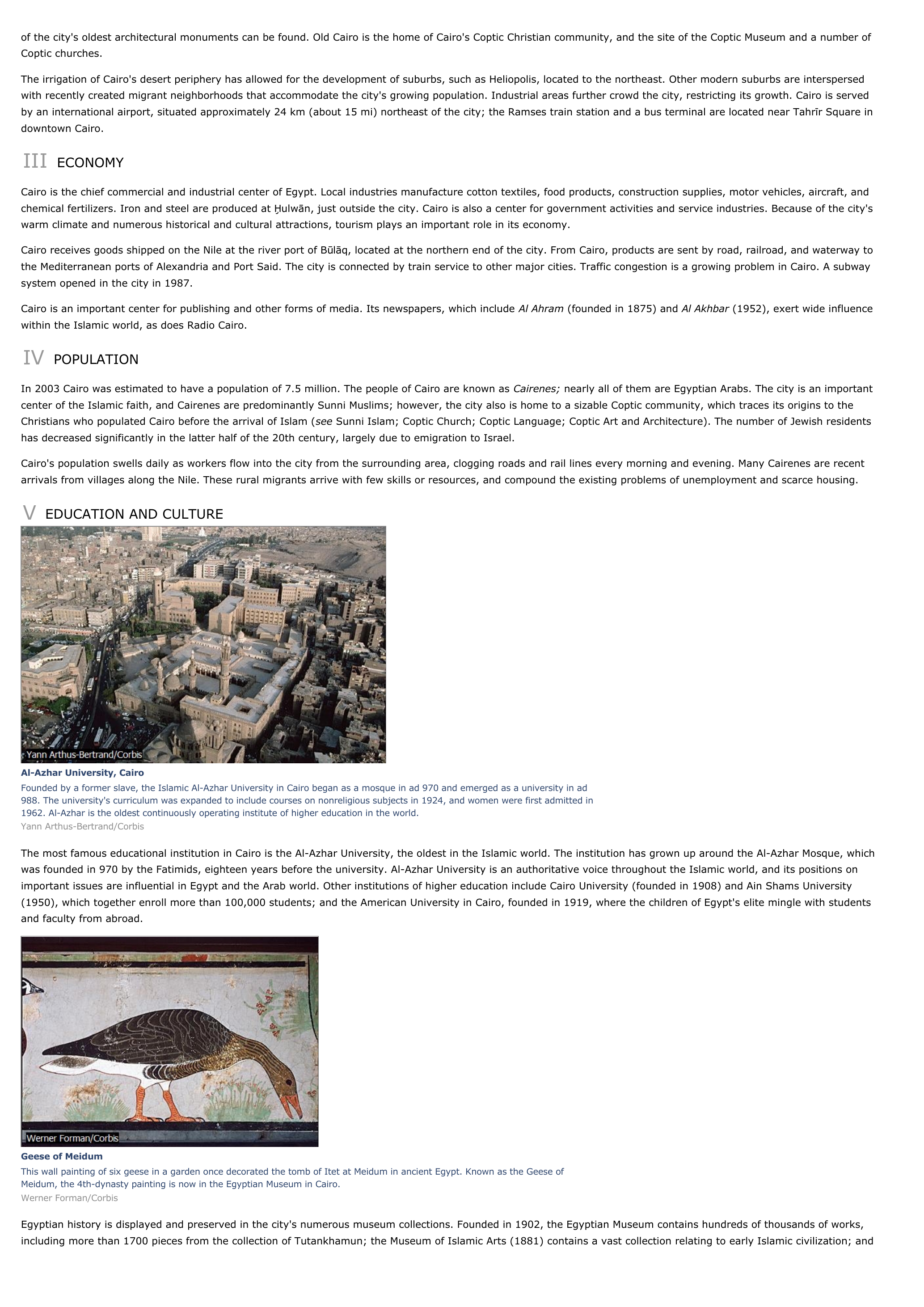Cairo (Egypt) - geography.
Publié le 27/05/2013

Extrait du document
«
of the city's oldest architectural monuments can be found.
Old Cairo is the home of Cairo's Coptic Christian community, and the site of the Coptic Museum and a number ofCoptic churches.
The irrigation of Cairo's desert periphery has allowed for the development of suburbs, such as Heliopolis, located to the northeast.
Other modern suburbs are interspersedwith recently created migrant neighborhoods that accommodate the city's growing population.
Industrial areas further crowd the city, restricting its growth.
Cairo is servedby an international airport, situated approximately 24 km (about 15 mi) northeast of the city; the Ramses train station and a bus terminal are located near Tahrīr Square indowntown Cairo.
III ECONOMY
Cairo is the chief commercial and industrial center of Egypt.
Local industries manufacture cotton textiles, food products, construction supplies, motor vehicles, aircraft, andchemical fertilizers.
Iron and steel are produced at Ḩulw ān, just outside the city.
Cairo is also a center for government activities and service industries.
Because of the city'swarm climate and numerous historical and cultural attractions, tourism plays an important role in its economy.
Cairo receives goods shipped on the Nile at the river port of B ūlā q, located at the northern end of the city.
From Cairo, products are sent by road, railroad, and waterway tothe Mediterranean ports of Alexandria and Port Said.
The city is connected by train service to other major cities.
Traffic congestion is a growing problem in Cairo.
A subwaysystem opened in the city in 1987.
Cairo is an important center for publishing and other forms of media.
Its newspapers, which include Al Ahram (founded in 1875) and Al Akhbar (1952), exert wide influence within the Islamic world, as does Radio Cairo.
IV POPULATION
In 2003 Cairo was estimated to have a population of 7.5 million.
The people of Cairo are known as Cairenes; nearly all of them are Egyptian Arabs.
The city is an important center of the Islamic faith, and Cairenes are predominantly Sunni Muslims; however, the city also is home to a sizable Coptic community, which traces its origins to theChristians who populated Cairo before the arrival of Islam ( see Sunni Islam; Coptic Church; Coptic Language; Coptic Art and Architecture).
The number of Jewish residents has decreased significantly in the latter half of the 20th century, largely due to emigration to Israel.
Cairo's population swells daily as workers flow into the city from the surrounding area, clogging roads and rail lines every morning and evening.
Many Cairenes are recentarrivals from villages along the Nile.
These rural migrants arrive with few skills or resources, and compound the existing problems of unemployment and scarce housing.
V EDUCATION AND CULTURE
Al-Azhar University, CairoFounded by a former slave, the Islamic Al-Azhar University in Cairo began as a mosque in ad 970 and emerged as a university in ad988.
The university's curriculum was expanded to include courses on nonreligious subjects in 1924, and women were first admitted in1962.
Al-Azhar is the oldest continuously operating institute of higher education in the world.Yann Arthus-Bertrand/Corbis
The most famous educational institution in Cairo is the Al-Azhar University, the oldest in the Islamic world.
The institution has grown up around the Al-Azhar Mosque, whichwas founded in 970 by the Fatimids, eighteen years before the university.
Al-Azhar University is an authoritative voice throughout the Islamic world, and its positions onimportant issues are influential in Egypt and the Arab world.
Other institutions of higher education include Cairo University (founded in 1908) and Ain Shams University(1950), which together enroll more than 100,000 students; and the American University in Cairo, founded in 1919, where the children of Egypt's elite mingle with studentsand faculty from abroad.
Geese of MeidumThis wall painting of six geese in a garden once decorated the tomb of Itet at Meidum in ancient Egypt.
Known as the Geese ofMeidum, the 4th-dynasty painting is now in the Egyptian Museum in Cairo.Werner Forman/Corbis
Egyptian history is displayed and preserved in the city's numerous museum collections.
Founded in 1902, the Egyptian Museum contains hundreds of thousands of works,including more than 1700 pieces from the collection of Tutankhamun; the Museum of Islamic Arts (1881) contains a vast collection relating to early Islamic civilization; and.
»
↓↓↓ APERÇU DU DOCUMENT ↓↓↓
Liens utiles
- Cairo (Egypt) - geography.
- Pyramids (Egypt) - geography.
- Pyramids (Egypt) - geography.
- El Cairo - geografía.
- Pyramids (Egypt) - history.

































